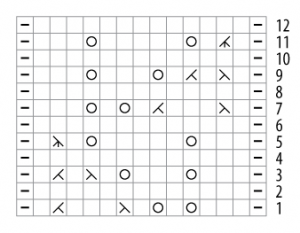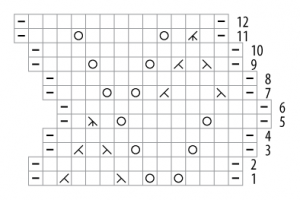Wavy is the way to go
By JC | April 29, 2010
A few weeks back, I posted a couple charts for a lace edging. Both had a zig-zag left selvedge (just like the edging), to account for the change in stitch count from row to row. But one also included “no stitch” symbols, so the symbols in the chart could line up vertical like the stitches in the knit edging. No surprise: most people preferred the second chart, despite its “no stitch” symbols, since it more closely resembled the knit edging.
Here’s another pair of charts, and a similar issue. (The key, as before, is here.)
Remember the rivulets swatch? The stitch pattern is of constant width—that is, its stitch count doesn’t change—and so it would typically be charted like this:
But the stitch pattern is so lovely in large part because it sways; it practically shimmies. Redrawing the chart makes this undulation apparent:
Bonus: this second chart also arranges the yarn overs and decreases as they appear in the knit swatch.
You’ve probably already guessed I prefer this second chart. I figure it’s clearer. Don’t you agree?
So I wonder why we don’t see more charts presented this way. Rivulets isn’t the only stitch pattern with wavy selvedges. The Gumdrops socks that I designed for Blue Moon Fiber Arts Rockin’ Sock Club feature a stitch pattern with wavy selvedges, and the leg chart in that pattern has wavy edges. As I recall, no-one in the RSC had a problem with that chart.
For wavy-edged stitch patterns, why do we see so many straight-edged charts? Or am I imagining things—do books or other publications that I’m unaware of use wavy-edged charts?





11 Comments